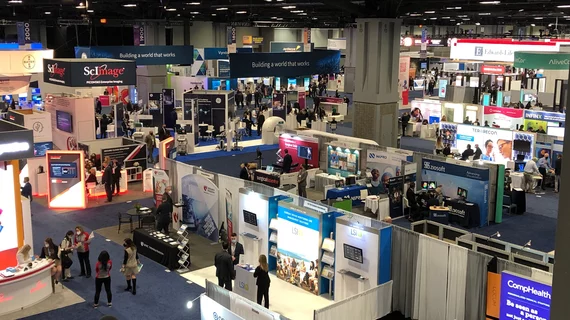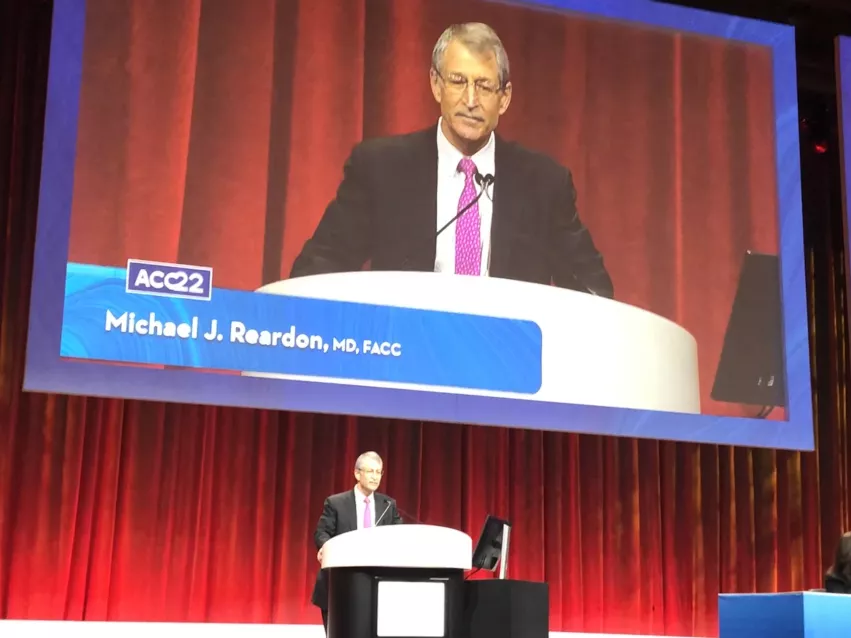ACC.22, the American College of Cardiology’s 71st Annual Scientific Session and Expo, saved some of its biggest late-breaking clinical trials for its final day.
Monday morning’s late-breakers began with a presentation by Daniel I. Sessler, MD, chair of the department of outcomes research at Cleveland Clinic. Sessler served as lead author of the PROTECT trial, which examined the potential cardiac benefits of aggressively warming patients to a temperature of 37° C — as opposed to the typical 35.5° C — during noncardiac surgeries. Overall, based on data from more than 5,000 patients with an average age of 67 years old, Sessler et al. determined that such a shift was not associated with any noticeable improvements when it came to cardiac complications, infections or blood transfusions.
“There was absolutely no benefit whatsoever,” he told the crowd.
Maura Marcucci, MD, assistant professor of clinical epidemiology and perioperative medicine at McMaster University in Hamilton, Canada, was next, presenting new data from the POISE-3 trial. She and her team found that blood pressure management strategies failed to reduce the number of major vascular complications among patients ages 45 and up who were undergoing noncardiac surgery.
The group tested both a hypertension-avoidance strategy and a hypotension-avoidance strategy, tracking data from more than 7,000 patients who were already taking at least one blood pressure medication. The average patient age was 70 years old, 56% were men and participants were randomized to either a hypertension-avoidance strategy or a hypotension-avoidance strategy.
Three studies focused on structural heart disease (SHD) were next. Michael J. Reardon, MD, a professor of cardiothoracic surgery and chair of cardiovascular research at Houston Methodist DeBakey Heart and Vascular Center, delivered perhaps the most highly anticipated results of the entire conference, announcing that transcatheter aortic valve replacement (TAVR) patients who received a supra-annular self-expanding heart valves experienced less structural valve deterioration after five years than those who received the same valve surgically. The SURTAVI trial, funded by Medtronic and focused on Medtronic heart valves, was a hot topic of conversation throughout the conference.
Watch the VIDEO: TAVR durability outperforms surgical valves — Interview with Michael Reardon, MD, at ACC22.
Adam Greenbaum, MD, associate professor of medicine and co-director of the Structural Heart and Valve Center at Emory University School of Medicine, shared the results of another key SHD trial, noting that the PASCAL repair system (Edwards) was associated with significant improvements in blood flow and in quality of life after one year among patients with tricuspid regurgitation. The system was associated with an implant success rate of 91%, procedural success rate of 88% and clinical success rate of 77%.
Learn m ore in the VIDEO: Pascal effective in transcatheter repair of tricuspid valve regurgitation — Interview with Adam Greenbaum, MD.
The day’s third late-breaking clinical trial focused on SHD was presented by Duk-Woo Park, MD, a specialist with Asan Medical Center in Seoul, South Korea. Park, the senior author of the ADAPT-TAVR trial, reported that the blood thinner edoxaban was linked to a lower rate of leaflet thrombosis than dual antiplatelet therapy among TAVR patients, though the difference was not significant.
Edoxaban was not associated with any reductions in the risk of stroke, transient ischemic attack or blood clots in the brain.
A few more to close out the conference:
During ACC.22’s final hours, there was still enough time for a handful of late-breaking clinical trials. Bon-Kwon Koo, MD, of Seoul National University Hospital in South Korea, joined virtually to share findings from the FLAVOUR randomized clinical trial, which concluded that percutaneous coronary intervention (PCI) guided by fractional flow reserve (FFR) was noninferior to PCI guided by intravascular ultrasound (IVUS) when treating patients with intermediate coronary stenosis. The team’s comparison of FFR-guided PCI and IVUS-guided PCI focused on the composite outcome of all-cause mortality, myocardial infarction and revascularization.
Also, Koo added, patients evaluated using FFR were much less likely to even undergo PCI.
Cesar Herrera, MD, director of the CEDIMAT Cardiovascular Center in Santo Domingo, Dominican Republic, was next, sharing an updated analysis of the ACC’s Global Heart Attack Treatment Initiative (GHATI).
Overall, Herrera reported, GHATI has shown improvements in patient care for STEMI patients in low- and middle-income countries over the course of two years. This two-year data is just the beginning for GHATI; program leaders aim to expand their efforts going forward to include even more interventions specifically designed to boost outcomes.
Marie-Sophie de Koning, MD, a physician scientist and PhD candidate at University Medical Center Groningen in the Netherlands, was next, presenting her team’s findings on the potential impact of sodium thiosulfate on STEMI patients. Previous studies on animal models had suggested sodium thiosulfate may be able to help protect the heart from ischemia-reperfusion injury, de Koning said. However, based on her group’s analysis of 380 STEMI patients, this does not appear to be the case.
Sodium thiosulfate was safe for these patients, de Koning noted during her presentation, but it was not associated with a significant reduction in infarct size.
The afternoon’s final late-breaker was presented by Mehdi Shishehbor, DO, MPH, PhD, president of the Harrington Heart and Vascular Institute at University Hospitals of Cleveland, and it is sure to grab the attention of interventional cardiologists. Shishehbor’s team found that the Chocolate Touch drug-coated balloon (DCB) (Genesis MedTech International) was safe and effective for peripheral artery disease patients presenting with superficial femoral and popliteal artery disease. The solution is designed to allow for the use of a slightly larger balloon, which helps open the patient’s artery a little wider than other DCBs.
Related ACC.22 Coverage:
Links to all the ACC 2022 late-breaking clinical trials
Key Interventional Cardiology Takeaways at ACC 2022
Find more ACC news, video and photos
Salt restrictions, PCI breakthroughs and a social media primer for cardiologists: Day 1 at ACC.22
Cholesterol medications, flu shots and heart failure: Day 2 at ACC.22



